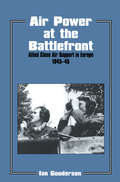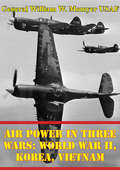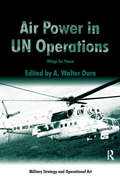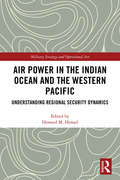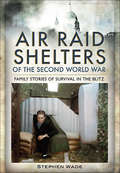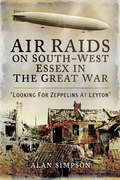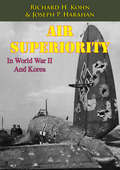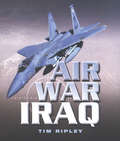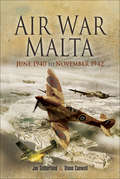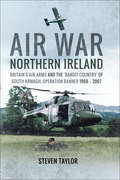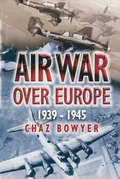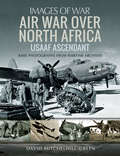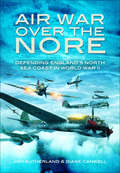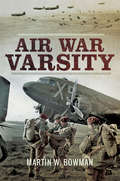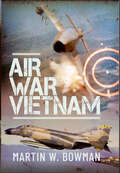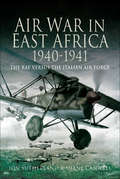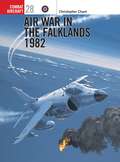- Table View
- List View
Air Power as a Coercive Instrument
by Ian O. Lesser Keith Crane Seth G. Jones Rollie Lal John G. Mcginn Daniel BymanCoercion--the use of threatened force to induce an adversary to change its behavior--is a critical function of the U.S. military. U.S. forces have recently fought in the Balkans, the Persian Gulf, and the Horn of Africa to compel recalcitrant regimes and warlords to stop repression, abandon weapons programs, permit humanitarian relief, and otherwise modify their actions. Yet despite its overwhelming military might, the United States often fails to coerce successfully. This report examines the phenomenon of coercion and how air power can contribute to its success. Three factors increase the likelihood of successful coercion: (1) the coercer's ability to raise the costs it imposes while denying the adversary the chance to respond (escalation dominance); (2) an ability to block an adversary's military strategy for victory; and (3) an ability to magnify third-party threats, such as internal instability or the danger posed by another enemy. Domestic political concerns (such as casualty sensitivity) and coalition dynamics often constrain coercive operations and impair the achievement of these conditions. Air power can deliver potent and credible threats that foster the above factors while neutralizing adversary counter-coercive moves. When the favorable factors are absent, however, air power--or any other military instrument--will probably fail to coerce. Policymakers' use of coercive air power under inauspicious conditions diminishes the chances of using it elsewhere when the prospects of success would be greater.
Air Power at the Battlefront: Allied Close Air Support in Europe 1943-45 (Studies in Air Power #Vol. 6)
by Dr Ian GoodersonIan Gooderson presents a study of close air support in World War II, with the analysis focusing on the use of tactical air power by British and American forces during the campaigns in Italy and northwestern Europe between 1943 and 1945.
Air Power in Three Wars: World War II, Korea, Vietnam [Illustrated Edition]
by General William W. Momyer USAF[Includes over 130 illustrations and maps]This insightful work documents the thoughts and perspectives of a general with 35 years of history with the U.S. Air Force - General William W. Momyer. The manuscript discusses his years as a senior commander of the Air Force - strategy, command and control counter air operations, interdiction, and close air support. His perspectives cover World War II, the Korean War and the Vietnam War.
Air Power in UN Operations: Wings for Peace (Military Strategy and Operational Art)
by A. Walter DornAir power for warfighting is a story that's been told many times. Air power for peacekeeping and UN enforcement is a story that desperately needs to be told. For the first-time, this volume covers the fascinating range of aerial peace functions. In rich detail it describes: aircraft transporting vital supplies to UN peacekeepers and massive amounts of humanitarian aid to war-affected populations; aircraft serving as the 'eyes in sky' to keep watch for the world organization; and combat aircraft enforcing the peace. Rich poignant case studies illuminate the past and present use of UN air power, pointing the way for the future. This book impressively fills the large gap in the current literature on peace operations, on the United Nations and on air power generally.
Air Power in the Falklands Conflict: An Operational Level Insight into Air Warfare in the South Atlantic
by John ShieldsFrom the television footage shown in all its stark reality and the daily coverage and subsequent memoirs, the impression delivered from the air battles in the Falklands Conflict was that of heroic Argentine pilots who relentlessly pressed home their attacks against the British. While, by contrast, there is a counter-narrative that portrayed the Sea Harrier force as being utterly dominant over its Argentine enemies. But what was the reality of the air war over the Falkland Islands? While books on the air operations have published since that time, they have, in the main, been personal accounts, re-told by those who were there, fighting at a tactical level, or back in their nation’s capital running the strategic implications of the outcome. But a detailed analysis of the operational level of the air war has not been undertaken – until now. At the same time, some analysts have inferred that this Cold War sideshow offers little insight into lessons for the operating environment of future conflicts. As the author demonstrates in this book, there are lessons from 1982 that do have important and continued relevance today. Using recently released primary source material, the author, a serving RAF officer who spent two-and-a-half years in the Falklands as an air defence navigator, has taken an impartial look at the air campaign at the operational level. This has enabled him to develop a considered view of what should have occurred, comparing it with what actually happened. In so doing, John Shields has produced a comprehensive account of the air campaign that has demolished many of the enduring myths. This is the story of not why, but how the air war was fought over the skies of the South Atlantic.
Air Power in the Indian Ocean and the Western Pacific: Understanding Regional Security Dynamics (Military Strategy and Operational Art)
by Howard M. HenselThis book examines the security dynamics of the Indian Ocean and the Western Pacific, concentrating upon an analysis and evaluation of the air power capabilities of the various powers active in the two regions. The volume is designed to help improve understanding of the heritage and contemporary challenges confronting the global community in the Indian Ocean and the Western Pacific, as well as to illuminate the policies of the various powers involved in the affairs of these regions, and the military capabilities that are available in support of those policies. The 16 individual chapters examine both the traditional and the non-traditional threats that confront the various Indian Ocean and Western Pacific powers, and assess the roles played by land-based and naval, fixed-wing and rotary-wing, manned and unmanned aircraft, as well as by offensively and defensively capable ballistic and cruise missiles in addressing these challenges. In doing so, the various chapters analyze and evaluate the air power doctrine, capabilities, deployment patterns, and missions of the respective states. In addition, they assess the future issues, challenges, and responses involving air power as it, acting in concert with other military instruments, seeks to contribute to securing and promoting the interests of the state. This book will be of much interest to students of air power, strategic studies, Asian and Middle Eastern politics, and International Relations.
Air Raid -- Pearl Harbor!: The Story of December 7, 1941
by Theodore TaylorIt examines from both the American and Japanese points of view the political and military events leading up to the attack on Pearl Harbor.
Air Raid Shelters of the Second World War: Family Stories of Survival in the Blitz
by Stephen WadeThis book features the design, creation and use of air raid shelters, including interviews with people who used them during the Second World War. The different types of bunkers/air raid shelters (both public and in peoples gardens) are covered and the strength and weakness of their designs discussed, using original designs and primary material. The nostalgia/social history of the book covers peoples experiences of staying in the air raid shelters. These are divided into topics, including getting to the shelters (how they reacted to the sirens or whether they just moved into the shelters, especially those in gardens, long-term), facilities, health issues, morale and safety, both real and perceived. In recent years, air raid shelters have been converted into different uses, including homes, and the book will finish with a brief chapter concerning the future and preservation of these once vital buildings.
Air Raids on South-West Essex in the Great War: Looking for Zeppelins at Leyton
by Alan SimpsonA quarter of a century before the Blitz of 1940, the inhabitants of south-west Essex were terrorized by an earlier aerial menace. Over the course of four years, German Zeppelins, Gothas and Giants flew above their homes, unleashing hundreds of highly explosive and incendiary bombs on London. During three of these raids, bombs were dropped on Leyton and many others landed elsewhere in south-west Essex. These early air raids are now largely forgotten in local memory, but for the inhabitants of the time the attacks were unprecedented, unexpected and lethal.In the years since the Great War a great deal of literature has been published on London's first air raids and about the defence network that evolved around the metropolis, but what happened in the capital's eastern suburbs and the nearby Essex countryside has received less coverage. This meticulously researched and insightful book attempts to put that right, looking at the area which, in 1914, was part of south-west Essex, but now comprises the London boroughs of Waltham Forest, Redbridge, Havering, Newham, and Barking and Dagenham.Focussing in particular on Leyton and Ilford, this is the first book to ever examine what happened before and after the raiders reached and bombarded the capital. The author has included a wide range of contemporary letters, diaries and newspaper reports from local sources, plus several previously unseen photographs. To set the story in its wider context, the book also contains a wealth of information about the defence of the London area generally and vivid reports from combatants on both sides.
Air Superiority Battle In The Middle East, 1967-1973
by Major Clarence E. Olschner IIIThis paper is an historical study of the strategy, tactics, and weapons employed by Israel, Egypt, and Syria in the battle for air superiority from 1967 through 1973. The study is developed chronologically beginning with the 1967 War, through the War of Attrition, and ending with the cease-fire in the 1973 War. It has been compiled from an extensive review of unclassified, primarily secondary, unofficial sources. The paper concludes that, in a mid-intensity war with modern air forces and air defense forces: 1) The achievement of strategic, tactical, and/or technological surprise can significantly influence the battle for air superiority, 2) Missiles have demonstrated the capability to significantly influence the air superiority battle in surface-to-air, air-to-air, and air-to-ground operations, 3) Air superiority can be achieved over the modern battlefield only by defeating both surface-to-air and air-to-air capabilities of the enemy, 4) The achievement of air superiority over the battle area requires the combined efforts of air and land forces of which long range artillery may be the most effective weapon for the suppression of surface-based air defenses.
Air Superiority In World War II And Korea [Illustrated Edition]
by Joseph P. Harahan Richard H. KohnIncludes over 20 illustrations.In November 1981, Lt. Gen. Hans H. Driessnack, Assistant Vice Chief of Staff, asked the Historical Program to assemble a small number of retired officers for a group oral history interview. General Driessnack believed that in reminiscing together, these officers would recall incidents and experiences that might otherwise go unrecorded; by exchanging ideas and questioning each other--in effect, interviewing each other--they would recall material that would be of interest and importance to the Air Force today. General Driessnack also suggested selecting retired officers from the senior statesman conference, a gathering every spring at which retired four-star generals are briefed on Air Force issues and then discuss them with contemporary Air Force leaders.The result is the following interview. The four participants--Gen. James Ferguson, Gen. Robert M. Lee, Gen. William W. Momyer, and Lt. Gen. Elwood R. "Pete" Quesada--gathered on May 21, 1982, around a table in the Vandenberg room at the Bolling Air Force Base Officers' Club. For approximately two and one half hours they responded to questions sent to them earlier and discussed air superiority in World War II and Korea. Their discussions ranged far and wide: flying in the pre-World War II Army Air Corps, campaigning in North Africa and Western Europe in World War II, planning and participating in the Normandy invasion, using secret intelligence supplied by Ultra, struggling to codify tactical air doctrine in the post-war years, fighting the air battle in Korea, and thinking about the general problem of air superiority throughout their careers. This collective interview is not history but the source material on which history rests; it is a memoir, a first-hand account by air leaders who flew, fought, and commanded tactical air forces in combat.
Air Supply Operations In The China-Burma-India Theater Between 1942 And 1945
by Major Adrian Rainier ByersThe USAAF responded to the requirement to keep China engaged against Japan by conducting two distinct air supply operations, a tactical air supply mission to Burma and a strategic air supply effort over the Himalayas to China. The tactical air supply effort to Burma supported offensive combat operations and the construction of the Ledo Road, while the Hump airlift directly contributed to the American strategic objective. Despite Stilwell's stubborn commitment to the Ledo Road as the main effort to supply the Chinese and to the necessary use of tactical air supply to support this and other ground operations in Burma, the key contribution to the success of keeping China in the war against Japan was ultimately the strategic air supply missions over the Hump. This thesis reviews how the operational airlift efforts within the CBI supported both efforts and examines the challenges, processes, and development of air supply. The fundamental question associated with this effort concerns how the USAAF responded to seemingly competing air supply requirements in the CBI Theater in order to keep China in the war against Japan.
Air War Iraq (Battlefield Britain Ser.)
by Tim RipleyThe book is a photo-journalistic record of the vitally important role that aviation played in the recent liberation of Iraq. It follows the part that American, British and Australian airpower played in each theatre of the campaign. It includes the many different missions that aircraft were tasked with, precision bombing, support of ground forces, clandestine air drops. Covering the initial build-up to the rapid and record-breaking advance on the capital it uses dramatic action photographs and first-hand accounts to portray the events as they unfolded.
Air War Malta: June 1940 to November 1942
by Diane Canwell Jon SutherlandThis is the story of the historic air defense of Malta by the WRAF against the combined attacking forces of the Italian and German air forces. The island was poorly equipped when Italy declared war on Britain in June 1940 and its only defense against air attack at the outset of war were 34 heavy and 8 light antiaircraft guns, one radar set and four Gladiator biplane fighters. The first air raids came on 11 July and from then on were an almost daily feature of life for the Maltese occupants and the island was in a state of siege. The loss of this strategic point in the central Mediterranean would threaten the major supply routes to the British Army in North Africa and deprive the Royal Navy of a vital base. Although hard-pressed at home and standing alone against Hitlers Europe, every effort was made by Britains government to get supplies, munitions and replacement aircraft to enable the island to withstand the naval and airborne onslaught. Convoy after convoy attempted to get through, Hurricane and Spitfire fighters were launched from aircraft carriers with only sufficient fuel for a one-way trip to the island. Many did not survive these heroic flights. Many famous British ships were lost due to torpedo and air attack, including the carriers Ark Royal and Eagle and the battleship Barham. The siege was finally raised on 20 November 1942.This book follows the islands wartime history, describing the heavily outnumbered WRAF defense against the many air-raids and how the small bomber force took the battle to Italian shores. It is a tale of outstanding bravery by the British forces and the Maltese people.
Air War Northern Ireland: Britain's Air Arms and the 'Bandit Country' of South Armagh, Operation Banner 1969–2007
by Steven TaylorThe story of the little-known battles between British helicopters and Provisional IRA units equipped with heavy machine guns, RPGs, and SAMs—includes photos. Famously dubbed &“Bandit Country&” by a UK government minister in 1975, South Armagh was considered the most dangerous part of Northern Ireland for the British Army and Royal Ulster Constabulary during the years of violence known as the Troubles that engulfed the province in the last three decades of the twentieth century. This was also true for the helicopter crews of the RAF, Royal Navy, and Army Air Corps who served there. Throughout the Troubles, the Provisional IRA&’s feared South Armagh brigade waged a relentless campaign against military aircraft operating in the region, where the threat posed by roadside bombs made the security forces highly dependent on helicopters to conduct day-to-day operations. From pot-shot attacks with Second World War-era rifles in the early days of the conflict to large-scale, highly coordinated ambushes by PIRA active service units equipped with heavy machine guns, rocket-propelled grenade launchers and even shoulder-launched surface-to-air missiles (SAMs), the threat to British air operations by the late 1980s led to the arming of helicopters operating in the border regions of Northern Ireland. Drawing on a wide range of sources, including official records and the accounts of aircrew, this book tells the little-known story of the battle for control of the skies over Northern Ireland&’s &“Bandit Country.&”
Air War Over Europe, 1939–1945: 1939-1945
by Chaz BowyerChaz Bowyer, arguably the most authoritative air historian of his generation, tackles the broad sweep of air operations in the European theatre in this book. Initially, the Luftwaffe attempted to dominate the skies, and very nearly succeeded. The valiant defence of the UK by the RAF in the Battle of Britain ranks among the greatest feats of arms in our country's history. The development of aircraft types and the descriptions of the actions that they and their pilots and crew fought make for great reading.
Air War Over North Africa: USAAF Ascendant (Images of War)
by David Mitchelhill-GreenThe decisive role of U.S. Army Air Forces in North Africa is vividly chronicled in this WWII pictorial history featuring rare wartime photographs. In 1942, General Erwin Rommel launched a surprise offensive in North Africa that brought a renewed threat to the Allied forces in the Middle East. United States Army Air Forces were quickly transferred to Egypt to assist the beleaguered British. Unaccustomed to the sprawling deserts of North Africa, the American airmen were confronted by sandstorms, flooding rains, extremes of temperature and primitive living conditions. Beyond these daunting conditions, they were pitted against an experienced and determined enemy. U.S. air power nevertheless played a decisive role in the Allied invasion of Northwest Africa and the subsequent surrender of Axis forces in Tunisia in May 1943. Later bombing missions flown from North Africa struck Axis targets across Europe and supported the Allied invasions of Sicily and mainland Italy. Featuring rare photograph from wartime archives, this volume in the Images of War series presents an illustrated account of U.S. fighter aircraft and bombers—including the iconic B-17 Flying Fortress, P-38 Lightning and B-24 Liberator—and the aircrews that fought to establish ascendancy over North African skies and beyond.
Air War Over North Vietnam: Operation Rolling Thunder, 1965–1968 (Cold War, 1945–1991)
by Stephen EmersonIn early 1965 the United States unleashed the largest sustained aerial bombing campaign since World War II, against North Vietnam. Through an ever escalating onslaught of destruction, Operation Rolling Thunder intended to signal Americas unwavering commitment to its South Vietnamese ally in the face of continued North Vietnamese aggression, break Hanois political will to prosecute the war, and bring about a negotiated settlement to the conflict. It was not to be. Against the backdrop of the Cold War and fears of widening the conflict into a global confrontation, Washington policy makers micromanaged and mismanaged the air campaign and increasingly muddled strategic objectives and operational methods that ultimately sowed the seeds of failure, despite the heroic sacrifices by U.S. Air Force and Navy pilots and crews Despite flying some 306,000 combat sorties and dropping 864,000 tons of ordnance on North Vietnam 42 per cent more than that used in the Pacific theater during World War II Operation Rolling Thunder failed to drive Hanoi decisively to the negotiating table and end the war. That would take another four years and another air campaign. But by building on the hard earned political and military lessons of the past, the Nixon Administration and American military commanders would get another chance to prove themselves when they implemented operations Linebacker I and II in May and December 1972. And this time the results would be vastly different.
Air War Over the Nore: Defending England’s North Sea Coast in World War II
by Diane CanwellThe Battle of Britain and the Atlantic and the Blitz are invariably the focus of books and perceptions of the air war over and around Britain during the Second World War. Yet, it was Britains more exposed eastern flank, from the South Foreland in the south to Bridlington in the north that faced nearly six years of unrelenting attacks by the Luftwaffe, the Kriegsmarine and, amazingly, the Corpo Aereo Italiano based in Belgium. The Italians alone launched some 150 raids on England hitting Great Yarmouth, Clacton, Harwich, Deal, Ramsgate and a host of other targets.This book chronicles the air war around the east coast as its principle focus but also incorporate the joint operations mounted by both the Allies and the Axis forces. It looks at the preparations for invasion, the defense of vital convoys, the air defenses, the coastal blitz, ship and crew rescue and crucial docks and shipyards. With so much attention paid to the south coast, the air war over the east coast was often fought on a shoestring although it was the coast that lay closest to Germany. It was not a war of vast fleets of warships and submarines, it was conflict staged by aircraft and smaller raiding craft. It also saw the biggest mine-laying campaign in history and the largest battle fought between Axis E Boats and Allied Motor Torpedo Boats. As the tide turned in Britains favor, the east coast became the staging post of the great bomber offensives against enemy occupied Europe and Germany itself. Yet the raiding and attacks on the east coast continued culminating in air-launched V1 attacks and finally V2 strikes.
Air War Varsity
by Martin W. BowmanHere, Martin Bowman brings us the first book on Operation Varsity to include both British and US air and ground operations, as well as the US, British and Canadian paratroop and resupply missions, all presented together in one ambitious volume.Operation Varsity-Plunder, the last large-scale Allied airborne operation of World War II, was certainly no walk-over. Varsity was the airborne part, whilst Plunder represented the British amphibious operations by the British Second Army.The airlift consisted of 541 transport aircraft containing airborne troops and a further 1,050 troop-carriers towing 1,350 gliders. The American 17th Airborne Divisions C-46 Commando transports and Waco gliders joined the British 6th Airborne Division C-54s, C-47 transport aircrafts, Horsas and Hamilcar gliders to form an immense armada that stretched for more than 200 miles across the sky. The successful air attack involved more than 10,000 Allied aircraft and was concentrated primarily on Luftwaffe airfields and the German transportation system.The combination of the two divisions in one lift made this the largest single day airborne drop in history. In this impressive account, Martin Bowman weaves firsthand testimony and a compelling historical narrative together with a variety of photographic illustrations, many of which have never been published before, in order to create a complete and fascinating record of events as they played out in March 1945.
Air War Vietnam
by Martin W. Bowman"Showcasing specific aircraft and highlighting significant missions illuminates the skills and emotions of the men who flew the machines. Bowman does an excellent job recounting stories about battles in the air and decision-making on the ground." — The VVA Veteran Martin Bowman’s revealing narrative of the aerial conflict in South-East Asia, 1965-1972, which had its beginnings in 1 November 1955, engulfed Viêtnam, Laos, and Cambodia and only ended with the fall of Sàigòn on 30 April 1975 has resulted from decades of painstaking fact-finding as well as detailed correspondence with surviving aircrew incorporating a wealth of first-hand accounts, some never told before, supported by dozens of rare and unusual photographs. Together they describe in adrenalin-pumping accuracy the furious aerial battles of a long suffering and bitter war in South-East Asia and in particular the frontline action in the skies over Vietnam that will keep readers on the edge of their seats. They too will find a new and useful perspective on a conflict that cost the Americans 58,022 dead and brought the USA worldwide condemnation for its role in Southeast Asia. Nearly 2,500 Americans remained ‘missing’. This work serves as a tribute to the courageous pilots who flew the F-104 Starfighter in the ‘Widowmakers’ war and B-52 bomber crews on ‘Arc Light’ ‘Linebacker II’ strikes and the eleven days of Christmas which ultimately ended the aerial campaign against North Viêtnam. And as well, strike aircraft such as the USAF F-4 Phantom and the F-105 ‘Thud’ and the US Navy carrier-borne jet and propeller-driven strike aircraft and the Americans’ sworn enemy, the North Việtnamese MiG fighters, feature large, from ‘Rolling Thunder’ onwards. Equally, the Hueys and Chinooks and other notable work horses that participated on combat assaults or Ash & Trash missions and transports like the C-130 ‘Herky-Bird’, C-123 Provider, Caribou and Viêtnamese C-47 - the ‘Haulers On Call’ - that performed sterling service during the gruelling air campaign are not forgotten either. Here, at first hand, are their stories which also include some of the less publicised American forces like the pilots and crewmen who flew the Bird Dogs and all manner of helicopters as well as the largely forgotten Australian and New Zealand Air Force units and the Anzac Battalions whose valuable contributions are too often overlooked. So too is the cost in human misery, death and destruction.
Air War in East Africa, 1940–41: The RAF Versus the Italian Air Force
by Diane Canwell Jon SutherlandThis little known campaign against the Italian invasion of British Somalia was bravely fought by a small force of elderly RAF and Commonwealth aircraft against almost overwhelming odds. This, against a backdrop of Britains meager assets being in demand in the much more prominent and important theatres such as Egypt and, of course, at home during the height of the Battle of Britain and the Blitz.The history starts with the Italians use of airpower and gas against the spear-armed Abbysinnians in 1936. In August 1940 the Italians attacked and overwhelmed British Somalia and under air cover the British evacuated to Aden. The Allies fought many air battles with the better equipped invaders and flew dangerous reconnaissance missions in preparation for the major offensives in 1941.On the Northern Front, the first phases see aggressive air patrols and Allied reinforcements arriving from Egypt. They attacked towards Agordat pushing deep into Eritrea from the Sudan. Meanwhile to the south the South African Air Force and ground forces attacked into Italian Somalia during January and February 1941. In March the allies attacked Keren and the Italians finally surrendered. The final allied air strikes against Asmara and Massawa led to the final collapse of Italian resistance in May 1941. The campaign in Ethiopia saw General Cunningham's force advances 1,725 miles from Kenya in 53 days to reach the Ethiopian capital Addis Ababa and liberating it on April 6 1941. However, the conflict was still not over there was continued resistance from 7,000 Italian troops and air operations continued against them until their surrender in September 1943.The book includes the experiences of the men who flew the outdated aircraft of the RAF and the SAAF in the campaign and includes many quotes and incidents from both Allied and Italian pilots.
Air War in the Falklands 1982
by Mark Rolfe Chris ChantThe Falklands War (1982), fought between the United Kingdom and Argentina for the possession of the Falkland Islands, was probably the last 'colonial' war that will ever be undertaken by the British. This book shows how the key to British success was the speed with which the British gained and then maintained air superiority over the islands and the waters around them with their small force of Sea Harrier STOVL warplanes, which operated from two aircraft carriers. Though subsonic, the Sea Harrier and its Sidewinder AAM were a combination altogether superior to Argentina's mix of supersonic and subsonic warplanes with older weapons, and this advantage was emphasised by the significantly greater tactical acuity of the British pilots. The Argentine pilots fought with considerable piloting skill and enormous courage, and scored a number of stunning successes against British warships, but ultimately they could not prevent the British landing and the following land campaign that resulted in complete Argentine defeat.
Air War on the Eastern Front (Casemate Illustrated #Cis0019)
by Mike GuardiaA pictorial history of Nazi Germany’s entire air campaign against the Soviet Union on the Eastern Front in World War II.The Red Air Force versus the Luftwaffe in the skies over Eastern Europe. June 1941: Having conquered most of Western Europe, Adolf Hitler turned his attention to the vast Soviet Union. Disregarding his Non-Aggression Pact with Joseph Stalin, Hitler launched Operation Barbarossa, a full-scale invasion of the Soviet homeland . . . aimed squarely at Moscow.In the skies over Russia, the battle-hardened airmen of the Luftwaffe made short work of the Red Air Force during opening days of Barbarossa. To make matters worse, Stalin had executed many of his best pilots during the perennial “purges” of the 1930s. Thus, much of the Red Air Force was destroyed on the ground before meeting the Luftwaffe in the skies. By 1944, however, the Soviet airmen had regained the initiative and fervently wrested air superiority from the now-ailing Axis Powers.“Will be of great interest to both modelers and aircraft historians alike.” —AMPS Indianapolis“This slim survey provides a quick, convenient intro to the deadly totalitarian duel. Make it a launchpad to further study of Eastern Front air combat in WWII.” —Cybermodeler“The prose is smooth and provides a top-level look at WWII German and Soviet air warfare.” —Historical Miniatures Gaming Society
Air Warfare in the Missile Age
by Lon O. NordeenLon O. Nordeen has completely updated his 1985 chronicle of military aviation's evolving role in warfare, now covering the major conflicts of the past four decades. He presents the historical and political background of each conflict and includes in-depth discussions of the aircraft, weapons, tactics, training, new systems, and other factors that influenced the outcome of each war. New and existing chapters have been enhanced with information based on recently declassified material--especially regarding Vietnam--and new sources in Egypt, Israel, and the former Soviet Union. As "smart" bombs have become more successful in reducing the risks for pilots and frontline troops, air-missile warfare has become the central player in military conflicts. Air Warfare in the Missile Age, Second Edition, is a valuable resource for understanding the evolution of modern air warfare.

